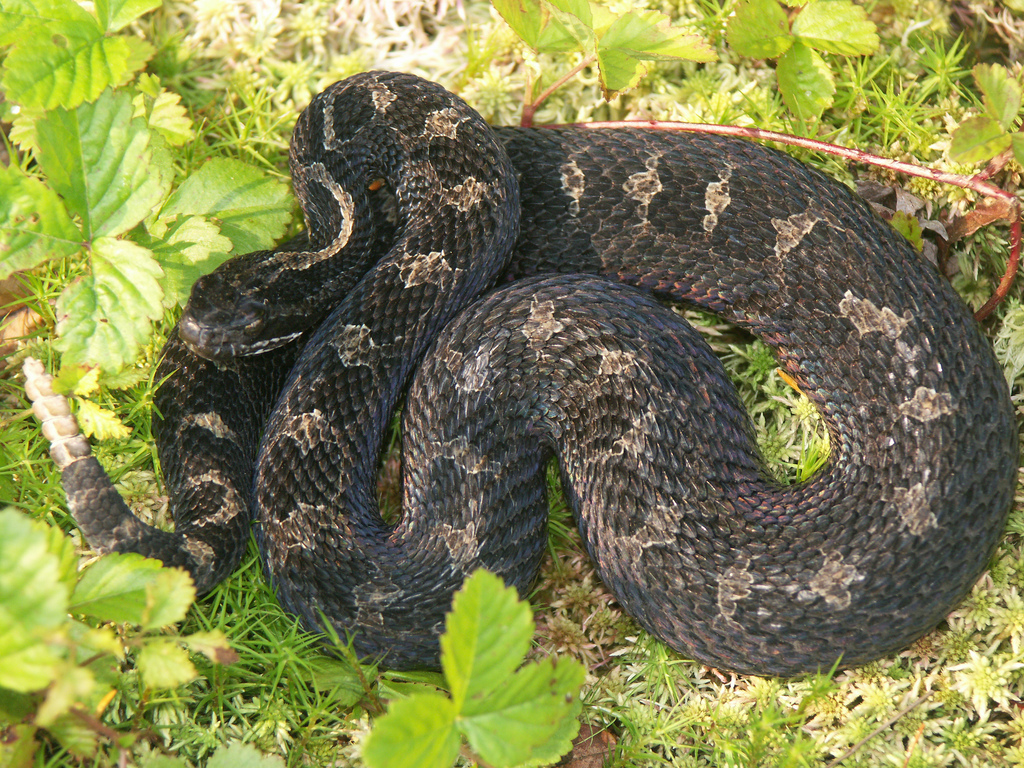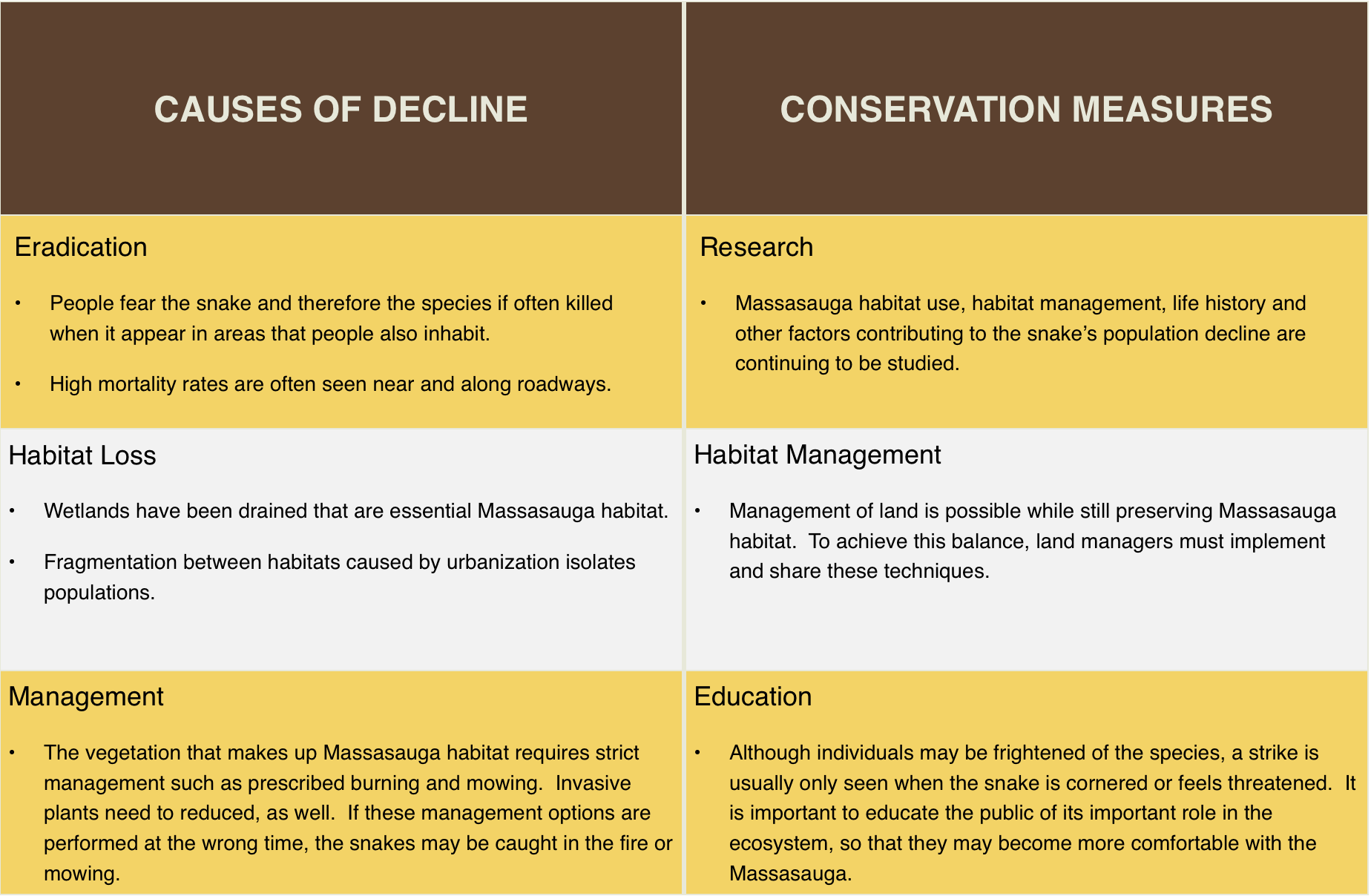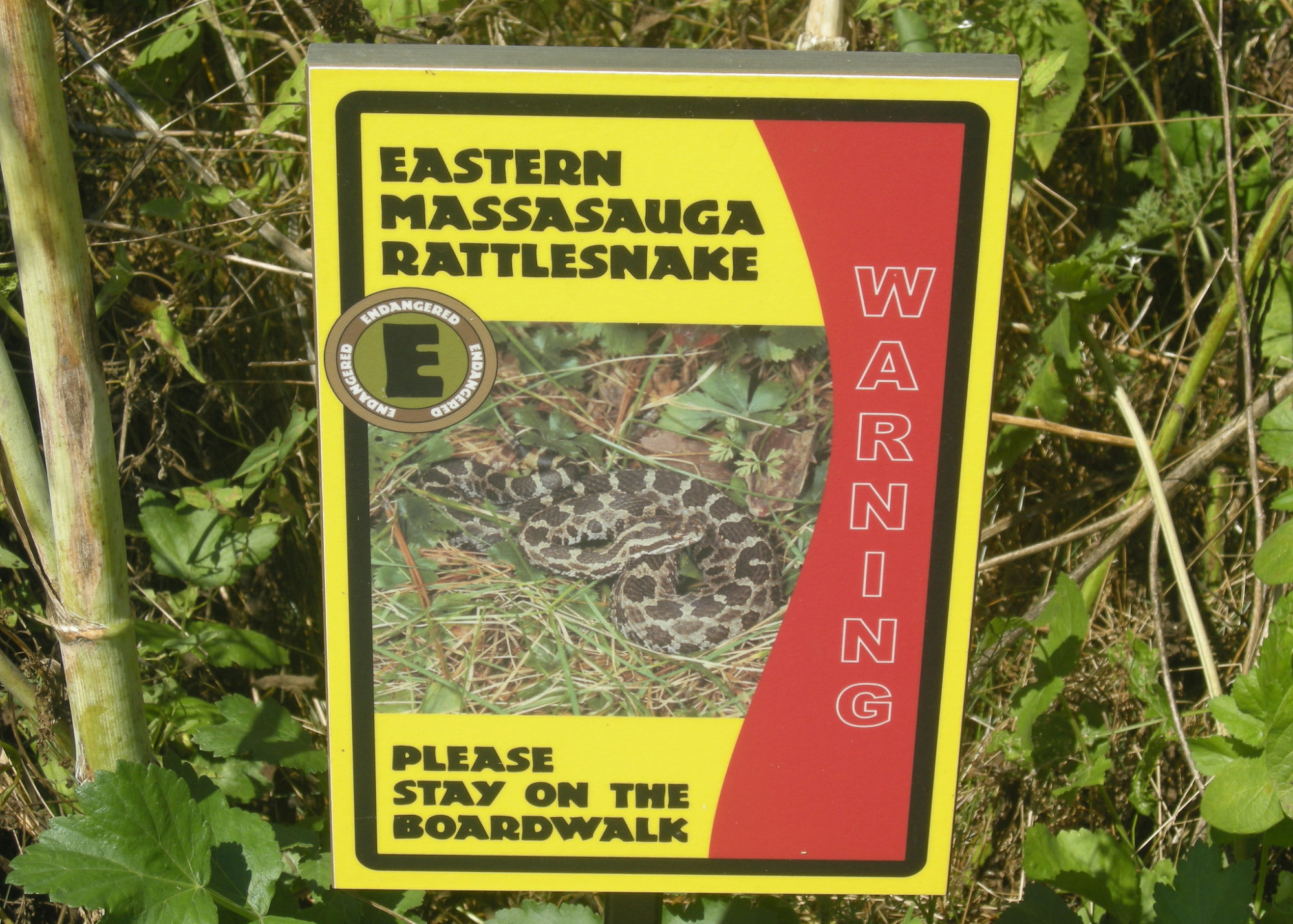Human-Wildlife Conflict
2.6 The Conservation of the Eastern Massasauga (Sistrurus catenatus) Rattlesnake
Kyleigh T. Godsey
The Eastern Massasauga has been extirpated from much of its historic range due to many anthropogenic threats. Can new research into the causes of decline of the species lead to its recovery? Will new conservation measures preserve the habitat that the species still occupies?

For many species, extinction due to anthropogenic causes is a looming threat. There are many threats that make survival difficult for the animals including habitat destruction, culling or hunting, prey items being killed due to pesticides or pollutants, non-native diseases, or competitors being introduced. For some species, the survival threat was overwhelming and caused their extinction. For others, like the Eastern Massasauga rattlesnake, there is still hope.
The Eastern Massasauga rattlesnake (Sistrurus c. catenatus) was originally a subspecies of the more widespread Massasauga rattlesnake (S. catenatus), a thick-bodied species of snake which inhabits a large range.3,8 Through efforts to conserve both this species and its unique genetic mark, the Eastern Massasauga was designated its own species in 2011.3 These rattlesnakes are considered pygmies when compared to the larger genus Crotalus, which are generally longer and rounder.4,11 Massasaugas typically reach an average length of 52-61 centimeters (20-24 inches).2,11 The Eastern subspecies has a historical range from eastern Iowa to western New York and from southern Illinois to southern Ontario.6,11 Despite having such a large range, populations are typically sparse and fragmented, with the majority in decline.3,6,11
The major causes of the decline of S. catenatus are habitat destruction and road mortalities.3,6,9,11 The eastern subspecies has been extirpated from most of its historical range, now existing in pockets along the Midwest.1,6,8 In states such as Minnesota, the possibility of a surviving population is infinitesimal, whereas Michigan has only experienced a loss of 33 percent of the original estimated population.1,8

The Eastern Massasauga survives in a variety of habitats including open-canopy forested regions for hibernation season, and wetlands such as shore marshlands, shrubby swamps, and fens in their active season.5,11,12 A seasonal habitat use pattern can be observed, as well as, habitat selection differing by the sex of the snake.5,12 Different habitats can result in different diets for the Eastern Massasauga.13 The rattlesnake occupies a predatory niche within each habitat.12,13 The diet of this species is typically small rodents with neonates sometimes preying on other snakes and adults preying on squirrels or rabbits.8,13 Eastern Massasaugas are preyed upon by raptors, carnivorous mammals, and other snakes.8
The destruction of the Eastern Massasaugas’ habitat is typically associated with urbanization or agricultural development, which fragments remaining habitats with roadways.2,11 All reptiles are ectothermic or, more specifically, poikilothermic, which makes roads dangerous because basking on a blacktop is a quick way for the animals to warm up.9 Other than providing a hazardous basking spot for the reptiles, roads divide multiple habitats forcing animals to cross at their own peril.9 For slow-moving rattlesnakes such as the Eastern Massasauga, this poses an even greater risk.9,11 A study conducted in reptile road mortality showed that there is a correlation between the number of deaths and the time of year in which the snakes are traveling.9 In mating season (August and September), males are typically killed more often.9,11 In the spring months, when Eastern Massasaugas move from their hibernacula to their summer habitats, there is also a spike in road related mortalities.9 While road sign indicators do not seem to help, reducing speed limits along roads within close proximity to high or medium-level Eastern Massasauga habitat may help drivers avoid hitting the snakes.9 Other solutions could involve making a passage beneath the road for the snakes, as well as other reptiles to use, but this also has its own risks such as an increased threat of predation.11
Along with the fragmentation of habitats on the small scale, the Eastern Massasauga is also fragmented in population.2,3,4 For most species, this is a cause for concern as it limits the gene pool of each population and deleterious genes can arise through inbreeding, a major pitfall for many endangered species.4 However, in a study conducted on small Eastern Massasauga populations, it was found that their numbers have not been greatly affected by inbreeding, and there is little evidence to suggest any negative effects have arisen.4 This may be because Eastern Massasaugas have historically low migration rates, thus making these isolated populations less at risk due to their secluded locations.3
Figure 3. Eastern Massasauga Rattlesnake Research.
Image 1: Eastern massasauga numbers are being monitored across the midwest, as the species has critically declined. The U.S. Fish and Wildlife Service works to complete surveys of the rattlesnakes to better manage their habitats and populations.
Image 2: To trap snakes, fences may be constructed to contain the snakes. The fences are temporary and guide the snakes to an area accessible by the researchers.
Image 3: Because the massasauga is a poisonous reptile, precautions must be taken when in close contact. Tools such as this are used by wildlife biologists to collect the snakes.
Image 4: An eastern massasauga rattlesnake captured from a survey is placed in a cloth bag for transport.
(Reference below)
Habitat destruction continues to disrupt Eastern Massasauga populations.1,3,4,11 Wetlands have been historically drained for agriculture in the Midwest, reducing the amount of space which these snakes can use for their summer hunting grounds.10,11 Non-native species of plants also pose a threat to the snakes’ open-canopy preference in forests.10 The Eastern Massasauga relies on these open canopies for sunlight, which gives the forest floor spots of warmth helping snakes regulate their body temperatures.10,11 With foreign shrubs now growing in these patches, the amount of basking locations is reduced.10 For the viviparous, gravid females, this could threaten survival rates when overwintering, if the neonates and mother cannot find adequate hibernacula.10,11
While steps should be taken to preserve the habitats in which populations of Eastern Massasauga survive, another approach, reintroduction, could help increase the numbers of this species. In a repatriation study, gravid females were removed from one stable population to give birth.7 Their neonates were raised in captivity while half, along with their mothers, were returned to their original population.7 The remaining neonates were released at a restored habitat which historically supported Eastern Massasauga populations.7 An autumn clutch was released as well as a summer group.7 While there were high mortality rates for each group, this study aligned with prior studies of mortality among wild Eastern Massasaugas, suggesting that this method of repatriation, rather than transplanting populations, could be an effective tool to help repopulate former Eastern Massasauga habitats.7
While efforts to save this declining species have had some success, there is still much to be done. Preserving natural habitats as well as rehabilitating old historical habitats will create more spaces for the species to occupy, thus reducing the risk of a bottleneck effect.3 Educating the public not only about the rattlesnakes and their importance to the ecosystem, but also on how to react when one is discovered while camping, hiking, or on one’s own property could significantly reduce the risk of mortality due to human exposure and prevent humans from being bitten. Educational outreach may help to preserve this species and create a more positive reaction with the public when increased repatriation attempts are pursued.

References:
- Bailey, R. L., et al. (2011). Survival of eastern massasauga rattlesnakes (Sistrurus catenatus catenatus) in Michigan. Herpetologica, 67(2):167-173.
- Bolton, R. M. (2013). The Massasauga Rattlesnake: Ontario Wildlife Video Series [Youtube Video]. The Art of Conservation. Retrieved from https://www.youtube.com/watch?v=WGW3MSt8nJI
- Chiucchi, J. E. & Gibbs, H. L. (2010). Similarity of contemporary and historical gene flow among highly fragmented populations of an endangered rattlesnake. Molecular Ecology, 19(24):5345-5358.
- Gibbs, H. L. & Chiucchi, J. E. (2012). Inbreeding, body condition, and heterozygosity-fitness correlations in isolated population of the endangered eastern massasauga rattlesnake. Conservation Genetics, 13(4):1133-1143.
- Harvey, D. S. & Weatherhead, P. J. (2006). A test of the hierarchical model of habitat selection using eastern massasauga rattlesnakes (Sistrurus c. catenatus). Biological Conservation, 130(2):206-216.
- Jones, P. C., et al. (2012). Range-wide analysis of eastern massasauga survivorship. The Journal of Wildlife Management, 76(8):1576-1586.
- King, R., et al. (2004). A repatriation study of the eastern massasauga (Sistrurus catenatus catenatus) in Wisconsin. Herpetologica, 60(4):429-437.
- Lipps, G.J. and Smeenk, N.A. (2017). Ohio Conservation Plan: Massasauga, Sistrurus catenatus. Conservation and recovery of the massasauga in Ohio. Ohio Biodiversity Ohio Division of Wildlife.
- Shepard, D. B., et al. (2008). Reptile road mortality around an oasis in the Illinois corn desert with emphasis on the endangered eastern massasauga. Copeia, (2):350-359.Shoemaker, K. T. & Gibbs, J. P. (2010). Evaluating Basking-Habitat Deficiency in the Threatened Eastern Massasauga Rattlesnake. The Journal of Wildlife Management, 74(3):504-513.
- Szymanski, J., et al. (2016). Species status assessment for the Eastern Massasauga Rattlesnake (Sistrurus catenatus). U.S. Fish and Wildlife Services, Endangered Species Division.
- Weatherhead, P. J. & Prior, K. A. (1992). Preliminary observations of habitat use and movements of the eastern massasauga rattlesnake (Sistrurus c. catenatus). Journal of Herpetology, 26(4):447-452.
- Weatherhead, P. J., et al. (2009). Diet of Sistrurus catenatus in Ontario and Ohio: Effects of Body Size and Habitat. Journal of Herpetology, 43(4):693-697.
Figures:
- Callaway, Dakota. (2012). [Photograph of Eastern Massasauga Rattlesnake Warning Sign in Cedar Bog State Nature Preserve]. Retrieved from FlickrCommons. CC BY 2.0.
- Chiucchi, James. (2007). [Photograph of Eastern Massasauga Rattlesnake]. Retrieved from FlickrCommons. CC BY 2.0.
- Kucera, Abbey, United States Fish and Wildlife Service. (2016). [Photograph of Eastern Massasauga, #1 in Gallery]. Retrieved from FlickrCommons. CC BY 2.0.
- Kucera, Abbey, United States Fish and Wildlife Service. (2016). [Photograph of temporary fence trap, #2 in Gallery]. Retrieved from FlickrCommons. CC BY 2.0.
- Kucera, Abbey, United States Fish and Wildlife Service. (2016). [Photograph of special handling tool, #3 in Gallery]. Retrieved from FlickrCommons. CC BY 2.0.
- Kucera, Abbey, United States Fish and Wildlife Service. (2016). [Photograph of snake in snake bag, #4 in Gallery]. Retrieved from FlickrCommons. CC BY 2.0.
